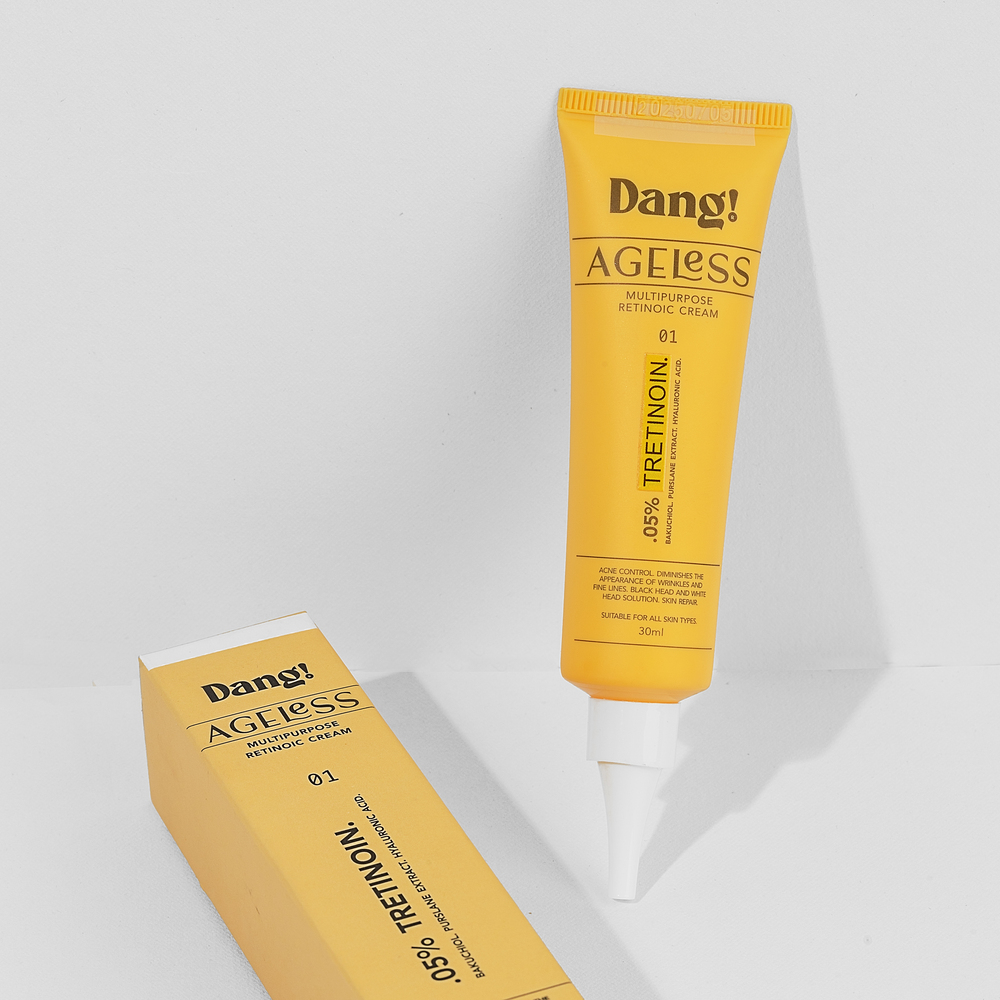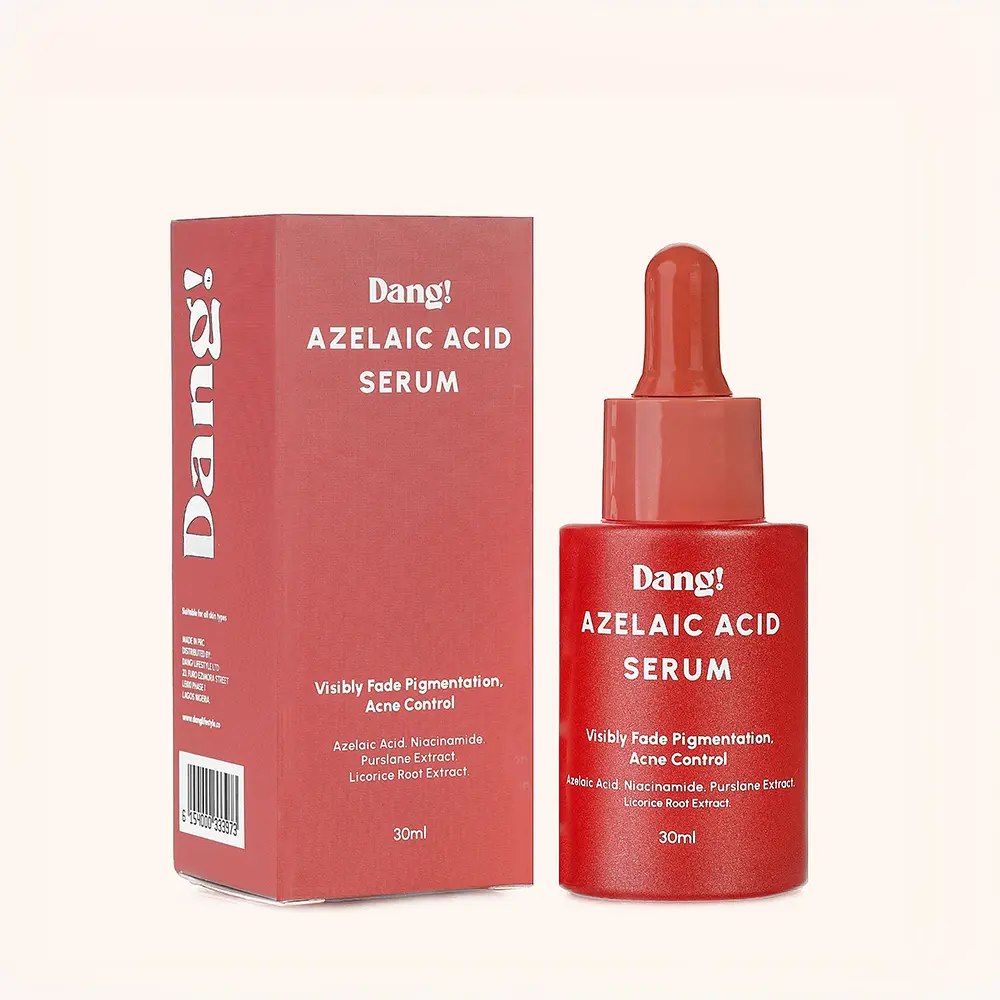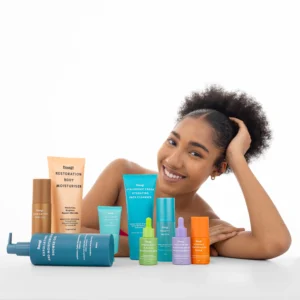
Free Shipping on Orders Over N200,0000 within Lagos
Buy 300k and get 20% off any spa service
Free Shipping For Orders over $150
Free Shipping For Orders over £100

You’re trying to get rid of acne and hyperpigmentation, and you’re wondering if you can use azelaic acid and retinol together to treat these skin concerns.
You can use azelaic acid and retinol together in your skincare routine. These are complementary skincare products that can address similar concerns and may enhance the results.
However, because they are both powerful actives, using them together in the same skincare routine can be tricky. Using them the wrong way may result in unpleasant side effects, like burns and skin irritation.
Keep reading to find out how to use the right way to use these skincare products in your skincare routine!

Derived from grains like wheat and barley, it soothes the skin and is effective in tackling issues like acne, rosacea, hyperpigmentation, and other related issues. It belongs to a class of acids called dicarboxylic acids.
Azelaic acid is a gentle exfoliant that fights acne, unclogs pores, and fades hyperpigmentation, leaving the skin smooth and radiant. To treat skincare concerns, you’ll find it in foam, serum, gel, cream, or pill form.
It is commonly used as a topical treatment (applied on top of the skin). However, the pill can only be used based on a doctor’s prescription, and the prescribed dosage is usually 10% to 15%.
Over-the-counter versions (creams, gel, or foam) can have it at 10% or less, and you may find it incorporated into skincare products in regulated concentrations.
Azelaic acid is a pretty cool ingredient for skincare. It’s mild but effective, and it’s great for sensitive skin. It’s also lightweight and non-comedogenic, so it won’t clog your pores or cause breakouts.
Here’s how azelaic acid helps your skin;
Some common side effects you may experience after using azelaic acid in the first few days include;
Rare/severe side effects include:
When you notice irritation or side effects, discontinue use immediately and consult a skincare professional

Retinoid, the superhero of the skincare world, is a chemical compound derived from vitamin A. This vitamin A derivative is famous for its anti-ageing prowess.
It stimulates collagen and elastin production, turning back the clock on your skin. This product not only minimises large pores, fine lines, and wrinkles but also transforms your skin texture.
Plus, it’s an effective topical treatment for acne and hyperpigmentation.
You’ll find retinoids in different forms, such as creams, gels, serums, ointments, and pills (recommended by a doctor).
The types of retinoids you’ll often come across are retinol and tretinoin.
Tretinoin is the type you’ll find in Dang products in cream form, with recommendations from our estheticians. So we’ll be answering your question: Can you use azelaic acid and retinol together with this type of retinoid in mind?
Tretinoin improves the overall health and appearance of the skin in two major ways.
It makes old, damaged skin cells die faster so that newer and healthier cells can take over. This unclogs your pores and prevents the formation of clogged hair follicles that can lead to acne.
This is why many people complain about irritation and rapid breakouts upon first use of tretinoin. However, signs of irritation and reactions usually reduce once the skin adapts to the treatment.
This reduces the appearance of fine lines, wrinkles, and enlarged pores, making the skin look younger and plumper.
You may experience the following when you first introduce tretinoin into your skincare routine:
If irritation or reactions persist, discontinue use immediately and consult with the professional who recommended you use it.
Both tretinoin and retinol are like cousins in the skincare family; they come from the same source, vitamin A, and tackle similar skin concerns. But they’re as different as night and day!
The big deal is their strength. Tretinoin is super concentrated and fast-acting. That’s great for results but can cause some intense reactions and irritation.
On the other hand, retinol is subtle and doesn’t necessarily need a prescription. It’s great for those easing into the world of retinoids.
Bottom line, tretinoin is super potent and needs to be used based on a prescription. Before you dive in, have a chat with a skincare professional. A professional will be your skincare coach, guiding you on how to use it and the right strength for your skin. With retinol, it’s a bit easier—just remember to start slow and enjoy the journey to better skin!

There’s a lot of information about the benefits of using azelaic acid and retinol together.
Research studies also justify the safe use and effectiveness of combining these two ingredients to treat hyperpigmentation.
Imagine azelaic acid and retinol as your skin’s dynamic duo, like crime-fighting partners in a superhero movie. They’re powerful on their own, but when combined, they’re an unstoppable force against acne.
Here’s how they team up to tackle your skincare concerns: azelaic acid steps in first, clearing pores and calming inflammation, setting the stage for retinol to work its magic. Retinol takes over, promoting healthy cell turnover, preventing pesky clogs, and reducing the chance of new breakouts.
The result?
A powerful combo that not only fights existing acne but also prevents future breakouts. So, yes, you can use azelaic acid and retinol together, but there are a few things to keep in mind.
First, be aware of your skin’s sensitivity. Retinol is a highly potent ingredient, so adding another active ingredient might intensify irritation, and if you have sensitive skin, proceed with care.
Using azelaic acid and retinol together can seriously level up your skincare game. It can lead to brighter, more youthful-looking skin, with azelaic acid focusing on reducing hyperpigmentation and retinol giving your skin a rejuvenating boost.
But here’s the golden rule: always, always seek guidance from a skincare professional or a dermatologist. They’ll be your superhero sidekicks, showing you the best way to include these ingredients in your routine and when to use them.
Your skin will thank you for it!
Picture this: Azelaic acid and tretinoin are like the dream team in the battle against acne, each bringing its own superpower to the table.
Azelaic acid is your skin’s new best friend. It fights acne-causing bacteria and calms the redness and inflammation they leave behind. Think of it as your skin’s peacemaker.
Tretinoin, on the other hand, is like your skin’s personal renovation crew. It works behind the scenes to speed up cell turnover, keeping your pores clear and ready to face the day. It’s like a tiny construction crew that is constantly improving your skin’s foundation.
Yes, you can, but there’s a right and wrong way to combine these ingredients.

Meet Sarah, a 35-year-old who’s had acne and hyperpigmentation for years. She tried many products without success. After reading about azelaic acid and retinol, she decided to try them. With patience and consistency, her skin improved.
If you’re like Sarah, struggling with acne and hyperpigmentation (dark spots), frustrated, and on the verge of giving up, don’t!
Get ready to level up in your skincare journey. Like your favourite music, your skincare routine should be a harmonious blend of the right notes and beats (in this case, products).
Here’s what our estheticians have to say about combining azelaic acid and retinol or tretinoin cream to treat acne and hyperpigmentation.
Azelaic acid, along with vitamin A powerhouses like retinol or tretinoin, are amazing for tackling acne and hyperpigmentation individually.
Using azelaic acid together with one of these ingredients, retinol or tretinoin, takes their effectiveness to a whole new level. It’s like having the dream team of skincare on your side!
However, we don’t recommend
This is because they may be prone to mild or severe irritation from either or both of these ingredients.
Instead, you could use one of these in your morning routine and the other at night (especially the retinol or tretinoin). Alternatively, you could alternate between these two ingredients, using one every other day.
Using retinol or tretinoin without professional guidance can lead to skin irritation, incorrect usage, and overuse. A skincare professional can give you custom advice depending on your skin type to ensure safe usage and optimal results.
So, seek professional guidance for the best outcomes and healthy skin.
It’s important to reiterate that it’s not ideal for people with hypersensitive skin (e.g. skin of colour) to combine these ingredients in the same routine.
By the same routine, we mean the morning or night routine.
So here’s the right way to incorporate these ingredients into any of your skincare routines:
This can be your daily routine if your skin has a high tolerance for this ingredient. However, for sensitive skin, you can skip some days.
When you first start using retinol, it’s best to start slowly and use it 2-3 times a day. This will help your skin get used to the ingredients and reduce the risk of irritation.
You can gradually increase the frequency of it over time, depending on how well your skin responds to it. The more sensitive your skin is, the less frequently you should use retinol or tretinoin.
Ready to invest in high-quality skincare that delivers results? Explore Dang Lifestyle’s premium collection of the best skincare products in Nigeria. Your journey to healthy, glowing skin starts here.
Azelaic acid and retinol can be a powerful duo in your skincare routine, addressing various concerns from acne to hyperpigmentation. While both offer remarkable benefits individually, combining them can work wonders.
To use these products the right way and reap the benefits, follow the guidelines provided in this article as you include them in your routine.
Remember that individual skin reactions may vary, and what works for one person might not work for another. Therefore, when in doubt or if you experience persistent side effects, consult a skincare professional.
Azelaic acid and retinol are both excellent ingredients for reducing acne scars. Retinol helps your skin produce collagen, which plumps up your skin and makes scars less visible.
Azelaic acid helps reduce inflammation and hyperpigmentation, which can also make scars less noticeable. In addition, retinol can be too harsh for sensitive skin, while azelaic acid is a milder option.
The bottom line is that both ingredients treat acne, but the best one for you depends on your skin type and specific skin concerns.
We do not recommend using azelaic acid and retinol on the same night. Here’s why.
Azelaic Acid and retinol both accelerate skin cells turnover which means when both are used together in the same routine, there’s higher chances of irritation.
So we recommend using both at alternate days in your night routine. For example azelaic acid on Tuesday and retinol on Wednesday.
Azelaic acid with concentrations ranging from 10% to 20% provides significant benefits for hyperpigmentation (dark spots) and post-inflammatory hyperpigmentation (PIH).
However, higher concentrations of 15% may be considered for stubborn or severe dark spots, but this should be under the guidance of a skincare professional.
Acne is the appearance of skin blemishes in the form of pimples, blackheads, whiteheads, reddish spots, and, in severe cases, nodules and cysts.
It occurs when your hair follicles become clogged with oil, resulting in excess sebum production, bacterial growth, and inflammation.
Getting rid of leftover acne scars (hyperpigmentation) is a gradual process. It requires patience and consistently using the right skincare products.
Using products like retinol and azelaic acid together in separate routines has been proven to help combat acne and fade off the residual scars gradually.
Does azelaic acid exfoliate the skin?
Yes. Azelaic acid can mildly exfoliate the skin, but it’s not considered a strong exfoliant. Instead, it’s gentler and its major benefits are reducing irritation, pigmentation, and blemishes.




